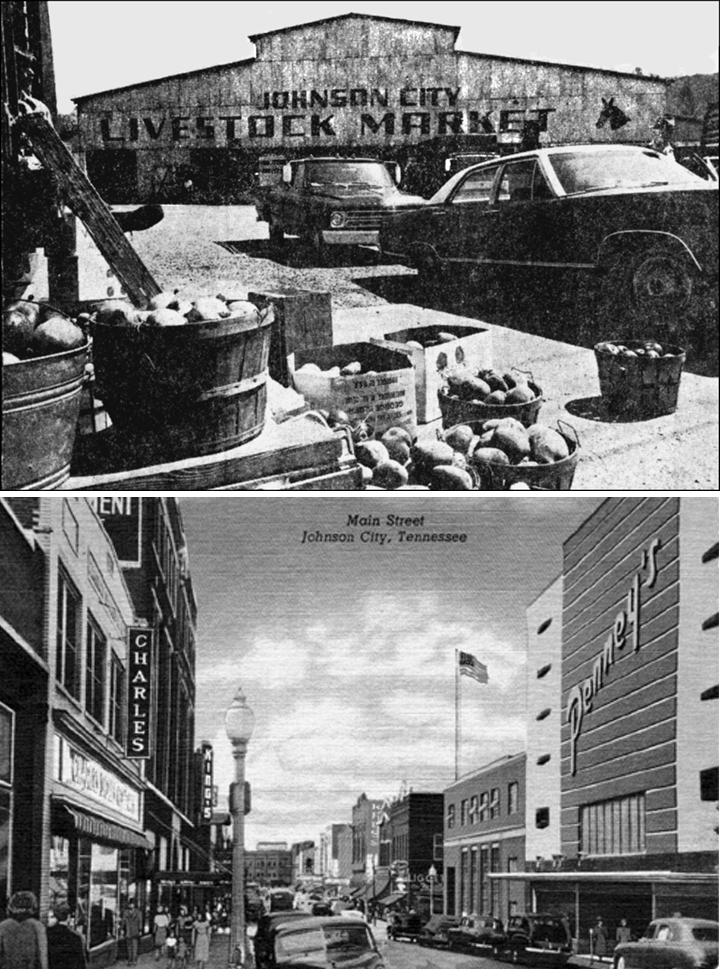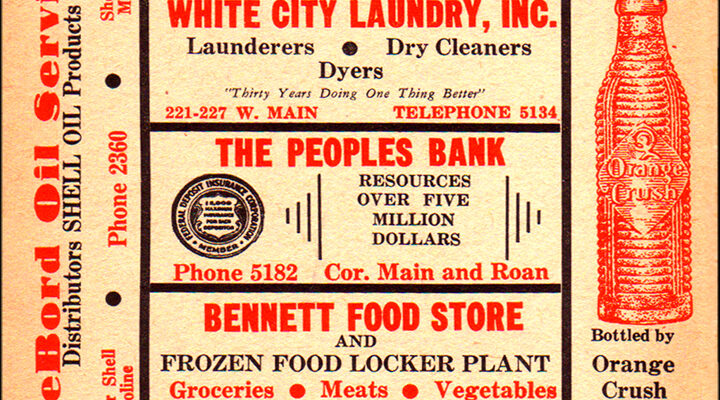In 1948, Johnson City was Tennessee’s fifth largest city with a population of 31,508. “The Hub of Tennessee,” as it became known, had experienced a population growth since the turn of the century: 1900, 4,645; 1910, 8,502; 1920, 12,442; 1930, 25,000: and 1940, 25,322. In 1948, officials provided some remarkable statistics about the city. It had a trading population in excess of 250,000 within a radius of 25 miles. Retail sales two years prior hit $26.9M.
In addition to the general products were lumber, building material, hardware supplies, dress goods, groceries, machinery and other allied lines of merchandise. The city served as the favorite retail shopping locale for the vast and fast-growing area.
By 1948, Johnson City was served by three railroads: the Southern Mail Line from Washington to New Orleans, the Clinchfield main line and the East Tennessee and Western North Carolina. Three U.S. Highways 11E (East and West), 19 (North and South) and 23 (North and South) contributed to traffic flow through the city. Also present was a million dollar airport that was the first stop of American Airways’ southern route out of Washington, with four planes flying daily.

Advertisements from a 1948 City Directory
Johnson City was the most diversified trading center of East Tennessee and one of the leading industrial centers. Local industries included hardwood flooring, furniture, textiles, rayon yarn, hosiery, fabricated steel, foundry products, bobbins and other products. There were 30 industries employing 4000 people with an annual payroll of slightly under $5M dollars.
In addition to the general mercantile products were lumber, building material, hardware supplies, dress goods, groceries, machinery and other related lines of merchandise. Retail sales for 1946 were $26,900,000.
Johnson City’s terrain was rich with a wide variety of raw materials including hardwood lumber, agricultural products, clay, shale, feldspar, coal, limestone, acid woods, water, mica, manganese and other natural resources, all of which existed in a crude and undeveloped stage.
The city was likewise proud of its Mountain Branch of the Veterans Administration Facility for Disabled Veterans. The reservation contained 450 acres of land on which were 76 buildings. It had six miles of asphalt-paved roads, three miles of secondary roads and its own “white way.” The value of the buildings and plants was appraised at $3,511,276, exclusive of the worth of equipment, which amounted to $785,733 or a total value of $4,297,049. The replacement value was estimated at $15M. There were 556 hospital beds, 1,723 duty and non-duty beds, and 330 unofficial barracks beds, making a total of 2,609 units. About 5,000 disabled World War veterans were admitted each year.
Johnson City was well served by a “Class A” school system with a splendid education system. In addition, there was an excellent Junior High School on N. Roan Street. The city boasted of providing the home for East Tennessee State Teachers College that had an annual enrollment of approximately 1,500 students. Nearby Milligan College had an annual roster of approximately 400 students. The 48 churches dispersed throughout the city covered practically all denominations. By this time, most of them had large congregations and modern church structures.
The civic clubs of the city in 1948 included the Chamber of Commerce, Junior Chamber of Commerce, Rotary, Kiwanis, Optimist, Civitan, Business and Profession Women, Pilot, Monday, Merchants Credit Association, as well as numerous patriotic, educational and music organizations.
The city was served with daily newspapers, both owned by Press, Inc. The Johnson City Chronicle was delivered in the morning and the Johnson City Press was distributed in the afternoon. It was also the home of radio station WJHL, which had just recently increased to 1,000 watts and had become a part of the ABC national hook-up at 910 on the radio dial. Station WETB, Johnson City’s newest station, broadcast from sun-up to sundown at 790 kilocycles.
Johnson City was recognized as being one of the outstanding burley tobacco centers of the Appalachian region. Within a radius of 70 miles of Johnson City, there was annual production of approximately 40-million pounds of burley tobacco. The quality and type of tobacco was up to standard and annually competed favorably with other markets in price and volume sales. The city had seven spacious tobacco warehouses with a combined floor space of 450,000 square feet of floor space.
With two sets of buyers, Johnson City could easily double the pounds sold. Thousands of tobacco growers preferred selling their product in Johnson City. Johnson City, being such a diversified retail and wholesale trading center, had a great advantage to the farmer in buying the necessities of life because, according to one slogan, “You can get it in Johnson City.”

Top: Johnson City Livestock Market As It Appeared on Broadway Street; Bottom: Main Street Looking West. Charles Store Is On the Left, Penneys on the Right
By 1948, the city had fast become the livestock and agricultural center of East Tennessee with the opening of a new livestock market. This was brought about by its ever-increasing number of quality mules and horses, the quality of its beef and dairy cattle, its fast-growing lamb production and an increase in poultry products. Washington County was in the midst of a soil improvement program aimed to prevent land erosion, increase lime in the soil and expand red clover across the land. Washington County was believed to have an enviable future in agricultural and livestock advancement.
The opening of the Johnson City Livestock Market in 1948 provided the handling of more than a thousand head of livestock each Wednesday.

Comments are closed.